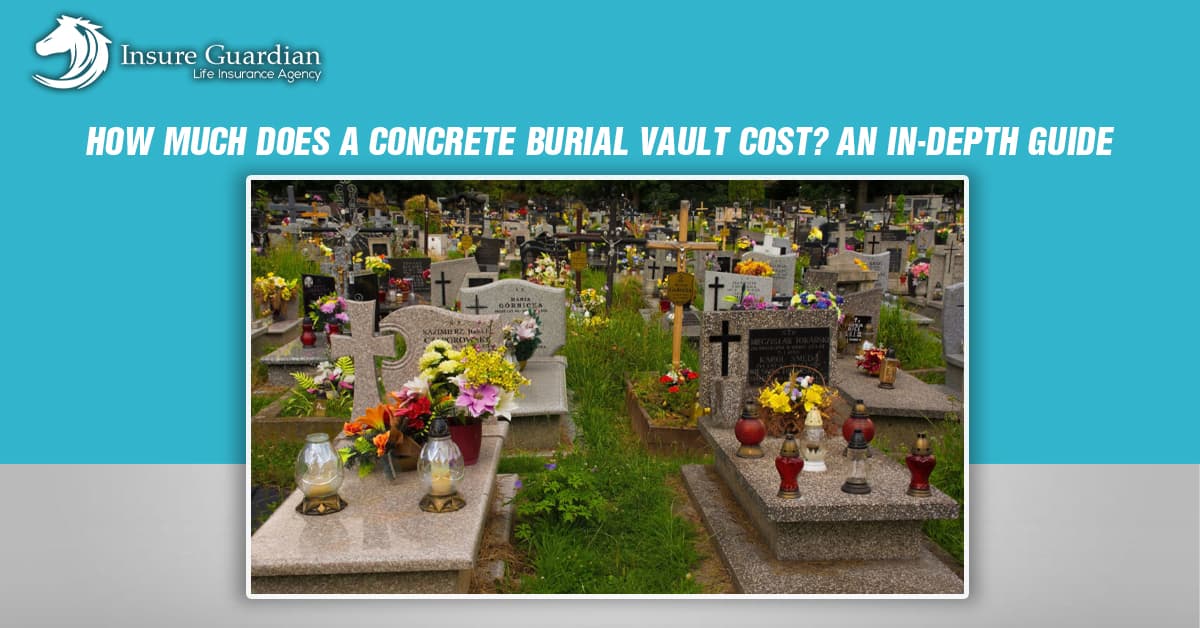Last Updated on: December 7th, 2024
Reviewed by Dylan
- Licensed Agent
- - @InsureGuardian
When planning a funeral, many people often overlook one essential but crucial element: the burial vault. A burial vault not only helps maintain the integrity of the grave but also plays an important role in protecting the casket from environmental elements like water, pressure, and erosion. But how much does a concrete burial vault cost, and what factors influence the price?
Table of Contents
ToggleThe cost of a concrete burial vault typically ranges from $800 to $5,000 or more, depending on several factors, such as the type of vault, materials used, level of protection, and customization options. For a basic model, prices can start around $800 to $1,500, while more advanced models with extra layers of protection or customization can reach higher price points.
Understanding these factors is essential for families to make informed decisions that fit their needs and budget. In this complete guide, we will walk through the key factors that influence the price of a concrete burial vault, explore the different types available, and provide a detailed overview of the costs involved to help you plan and budget effectively for funeral arrangements.
What is a Concrete Burial Vault?
Before we go deep into the cost of the concrete Burial Vault, it’s important to understand what a concrete burial vault is and why it is used.
A concrete burial vault is a protective container made from concrete that is placed around a casket before it is buried. Its primary purpose is to protect the casket from the weight of the earth, water, and any external elements that could cause the grave to collapse or deteriorate over time. Most cemeteries require the use of a burial vault or outer burial container (OBC) to prevent the ground from settling and to maintain the aesthetic appearance of the cemetery.
Also Read: Coffee Table Burial
Why Do You Need a Concrete Burial Vault?
While no state or federal law mandates the purchase of a burial vault, many cemeteries require it as part of their regulations. Some of the reasons cemeteries require burial vaults include:
- Preventing Ground Settlement: Without a vault, the casket could eventually collapse under the weight of the earth, causing the grave to sink.
- Casket Preservation: Concrete vaults can help protect the casket from the intrusion of water and grave-site substances, prolonging its integrity.
- Maintaining Cemetery Appearance: By preventing graves from sinking, burial vaults contribute to the overall neatness and appearance of the cemetery grounds.
Key Factors That Influence the Cost of Concrete Burial Vaults
The price of a concrete burial vault can differ significantly based on a number of factors. Understanding these variables can help decide which type of vault best fits your needs and budget.

- Level of Protection: One of the primary factors that affect the price of a burial vault is the level of protection it provides. Burial vaults come with varying degrees of protection against water, earth, and pressure.
- Outer Burial Containers (OBC): These are the most basic type of vault and are typically made of reinforced concrete. Their purpose is to prevent the casket from collapsing but do not offer protection against water intrusion. OBCs are generally the most affordable option.
- Concrete Burial Vaults with Seals and Linings: A standard concrete vault can come with layers of sealing material, often made from plastic or asphalt. These vaults provide better protection from moisture, groundwater, and other contaminants. The more advanced the seal, the higher the price.
- Advanced Multi-Layered Vaults: The highest quality vaults come with multiple layers of protection, including metal sheeting, plastic liners, and extra sealing materials. These provide superior protection and can cost significantly more.
Also More: Tree pod Burial: Become A Tree When You Die
How Much Does Life Isurance Cost?
1. Material Used in Construction
The materials used in the construction of the burial vault also contribute to the cost. Concrete is the most commonly used material, but it can be enhanced with other substances like polystyrene or metal liners to improve water resistance and overall durability.
- Basic Concrete Vaults: The simplest and most affordable option, providing basic protection from the weight of the earth but limited water resistance.
- Sealed Concrete Vaults: These vaults are lined with waterproofing materials like polystyrene or asphalt, ensuring better protection from groundwater and moisture.
- Metal Lined Vaults: Some vaults use stainless steel or copper linings for added protection and durability, which increases their cost but provides excellent longevity and resistance to environmental elements.
2. Customization and Personalization
Many families opt to personalize their burial vault with additional features. Customization can include decorative elements like metal caps, emblems, handles, or even photographs of the deceased. While these add a personal touch, they also increase the overall price of the vault.
Some people might also opt for higher-end finishes, such as a painted finish or additional features that give the vault a more personalized or memorialized look.
3. Size and Dimensions
Not all graves are the same size, and neither are burial vaults. Vaults can be made to accommodate different casket sizes, and custom vaults may incur additional costs. Larger vaults or those made for oversized caskets will generally be more expensive than standard models.
Also Read: Is Burial Insurance Taxable?
Average Cost of Concrete Burial Vaults
When it comes to pricing, concrete burial vaults can range widely depending on the factors mentioned above. Here’s an overview of the typical price range for different types of burial vaults:
- Basic Concrete Grave Liners: These cost between $800 to $1,500. Grave liners are the least expensive option and provide the minimum protection required by most cemeteries. They prevent the grave from collapsing but offer no protection against moisture or external elements.
- Standard Concrete Burial Vaults: Prices for these start around $1,500 to $3,000. These vaults often include some form of waterproofing or sealing to protect the casket from water and other environmental factors.
- High-End Concrete Burial Vaults: These can cost anywhere from $3,000 to $5,000 or more. Vaults in this range are typically lined with high-quality materials, such as polystyrene, and feature superior waterproofing and durability.
- Customized or Premium Vaults: If you opt for a personalized vault with special decorative features or additional metal linings, the price could exceed $5,000.
– Additional Costs to Consider
While the price of the burial vault itself is a significant expense, there are other costs to consider:
- Installation and Delivery Fees: Many cemeteries charge a separate fee for the delivery and installation of the vault. This can range from $200 to $500, depending on the cemetery’s location and the distance the vault must be transported.
- Cemetery Fees: In addition to the cost of the vault, cemeteries may charge fees for things like the grave opening, site preparation, and equipment used to place the vault in the ground.
- Sales Tax: Be aware that sales tax is often added to the price of the vault, and this can vary depending on your state.
Also Read: Green Burial Cost: Exploring Benefits, Cons, and Alternatives
Can You Buy a Concrete Burial Vault Online?
Yes, it is possible to purchase a concrete burial vault online. However, there are several important considerations to keep in mind:
- Shipping and Delivery: Since burial vaults are heavy and large, shipping fees can be quite high, and delivery times may vary. It’s essential to coordinate with the funeral home and cemetery to ensure the vault arrives on time.
- Customization: While basic vaults can be easily purchased online, if you’re looking for customization (like decorative features or special finishes), it’s often better to work directly with a funeral home or local distributor.
- Cemetery Requirements: Not all cemeteries accept burial vaults bought online, so it’s crucial to verify that the vault meets the cemetery’s specifications before purchasing.
Financing Options for Burial Vaults
The cost of a burial vault may be significant for some families. Fortunately, many funeral homes and cemeteries offer financing options. These may include:
- Prepaid Funeral Plans: Some funeral homes offer the option to prepay for burial vaults and other funeral expenses. This allows families to lock in the price and avoid inflation over time.
- Installment Payment Plans: Some providers offer installment plans, where the cost of the vault can be spread out over time. These options may come with interest, so it’s essential to read the terms and conditions.
Also Read: Difference Between Burial Insurance and Funeral Life Insurance
Conclusion: Making an Informed Decision About Burial Vault Costs
A concrete burial vault is an important investment that helps protect the casket and preserve the integrity of the grave. The cost of a burial vault can range from $800 to $5,000 or more, depending on factors such as the level of protection, material used, customization, and additional fees.
When planning for the cost of a burial vault, it’s essential to consider not only the price of the vault itself but also additional costs like delivery, installation, and cemetery fees. Furthermore, understanding the different type s of vaults and the level of protection they offer can help ensure that you make the right choice for your needs.
By shopping around, considering financing options, and working with your funeral director or cemetery representative, you can find a burial vault that fits both your budget and the requirements of your cemetery.
Frequently Asked Questions (FAQs)
1. What is the difference between a grave liner and a burial vault?
A grave liner is a basic concrete container that prevents the grave from collapsing, but it offers no protection from water. A burial vault, on the other hand, is sealed and lined to provide additional protection from moisture and the elements.
2. What factors affect the price of a concrete burial vault?
The price depends on factors like the material (concrete vs. metal lining), level of protection (sealed vs. non-sealed), size of the vault, and any customization features (e.g., decoration, nameplates).
3. Can I buy a concrete burial vault online?
Yes, but it’s important to ensure that the vault meets the requirements of the cemetery, and that delivery and installation are coordinated.
4. Is financing available for burial vaults?
Yes, many funeral homes and cemeteries offer financing options, including prepaid plans or installment payment plans.

Expert Life Insurance Agent and health insurance agent
Dylan is your go-to guy for life and health insurance at InsureGuardian. He’s helped over 2,500 clients just like you figure out the best insurance plans for their needs. Before joining us, Dylan was sharing his expertise on TV with Global News and making a difference with various charities focused on health. He’s not just about selling insurance; he’s passionate about making sure you’re covered for whatever life throws your way.







